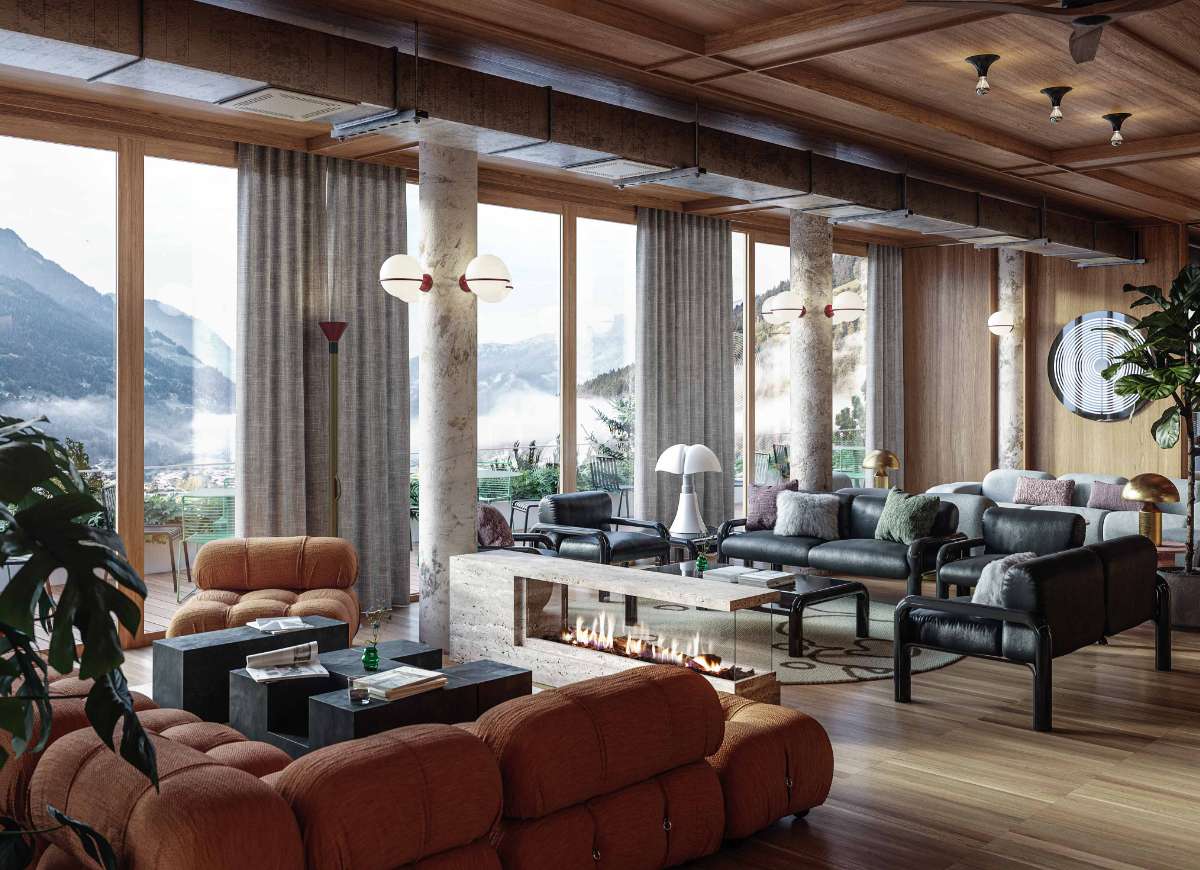
Modern meets mid-century at The Cōmodo, a new design hotel in the Austrian mountain town of Bad Gastein that evokes a nostalgia for the alpine resorts of the 1960s and pays homage to the wellness heritage of its locale.

Modern meets mid-century at The Cōmodo, a new design hotel in the Austrian mountain town of Bad Gastein that evokes a nostalgia for the Alpine resorts of the 1960s and pays homage to the wellness heritage of its locale.
Bad Gastein is having a renaissance. The ski and spa town, which sits high in the Austrian Alps, not far from Salzburg, has a legacy of wellness travel (‘bad’ translates to ‘spa’ in German). Large Belle Époque hotels dot its steep streets, relics of an era in the 19th century when European royalty frequently flocked here, drawn by its natural beauty and the healing waters of its thermal springs.
Waning popularity in the 1960s saw many of its hotels sit empty, but the decades-long hiatus appears to be over, thanks to a collective of restaurateurs, artists, and architects who are putting the ski town back on the map.
The Cōmodo, a recently opened boutique property, is one such project designed to entice travellers seeking a modern mountain refuge in which to experience Bad Gastein’s magic.
“Here, in Bad Gastein, history is repeating itself a bit,” says Barbara Elwardt, the architect behind The Cōmodo. “For more than 40 years, the magnificent buildings faded away, but there is now this new beginning. Bad Gastein feels to me like Berlin used to: crazy and lively, a spirit of optimism in a historic setting.”
Elwardt piloted the project alongside the Berlin-based designer, Piotr Wisniewski, and their agency, weStudio. The 70-room hotel, which is a member of Design Hotels, was built in what was formerly a clinic, with the bones of the structure retained and renovations made using sustainable materials. The designers have imbued a nostalgic, mid-century aesthetic in a manner that is refreshingly contemporary and attuned to the heritage of this alpine destination.
Design Inspiration
Piotr Wisniewski’s vision was centred on three main themes: the Alpine resort of the ’60s, the ambience of a Viennese café, and The Cōmodo’s stunning natural setting. A sense of place is evoked in the custom-designed furniture, wallpapers, rugs, and artwork, which allude to the colours and contours of the mountains that are viewable through the property’s panoramic windows. The colour palette includes Cōmodo red and green, complemented with yellow, blue, and light grey, which Wisniewski says represent “warmth, connection, and art.” Original terrazzo flooring is paired with materials like local oak and pine, which were chosen to connect to the history of the site and lend a polished feel, without leaning too heavily on minimalism.
“We strived for an honest but playful, yet sophisticated, contemporary mountain retreat that proves history can blend with technology; where vintage meets modern, where functionality does not mean boring,” says Wisniewski.
Vintage furnishings reinforce this sentiment, with pieces sourced from private collections, auction houses, galleries, and second-hand websites and reupholstered in leather. Wisniewski’s standouts include a Joe Colombo Elda chair; rare, original ’60s lighting pieces; and timber chairs by the Polish architect and designer, Rajmund Teofil Hałas.
In the lobby lounge, a red Camaleonda sofa by Italian designer Mario Bellini is a nod to the nearby Brutalist-style congress centre, designed by Gerhard Garstenauer, where public areas were furnished with Camaledona sofas when it opened in 1974. Artisans were selected by weStudio to create distinctive décor such as mirrors, tapestries, carpets, prints, and wall designs for the guest accommodations, which range from 19 to 50m2.
Sustainability
“Today’s design approach does not translate to the final effect only, but also through the idea that stands behind it,” notes Wisniewski, and sustainability was key in the design approach at The Cōmodo. Recycled materials were used where possible, and natural materials such as solid oak and local marble were chosen for their durability. The hotel is powered by solar panels and efficient heating systems have been implemented. An onsite water system connects directly to the mountain spring, and refillable glass bottles are offered to guests.
Staying here
Along with 70 guest accommodations, the property has a communal ‘living’ room, a spa, a farm-to-table restaurant, a bar, and a summer garden. Modern spaces include a co-working library and a lecture room/small cinema adjacent to the bar. All the hotel spaces are designed for guests to come together, socialise, and have fun in a relaxed yet sophisticated environment.
At the restaurant, menus are based on Austrian cuisine made using fresh, organic ingredients from local farms. Premium Winzersekt, an Austrian sparkling wine, is served alongside classic cocktails.
Depending on the season, guests can take advantage of close to 220km of long, steady ski runs in the Gastein Valley in winter or set out on restorative hikes in the warmer months.
Room rates start at €175 (about AUD$280) per night.
Photography courtesy of Design Hotels
Latest Articles
Don't miss the latest from Luxury Travel
